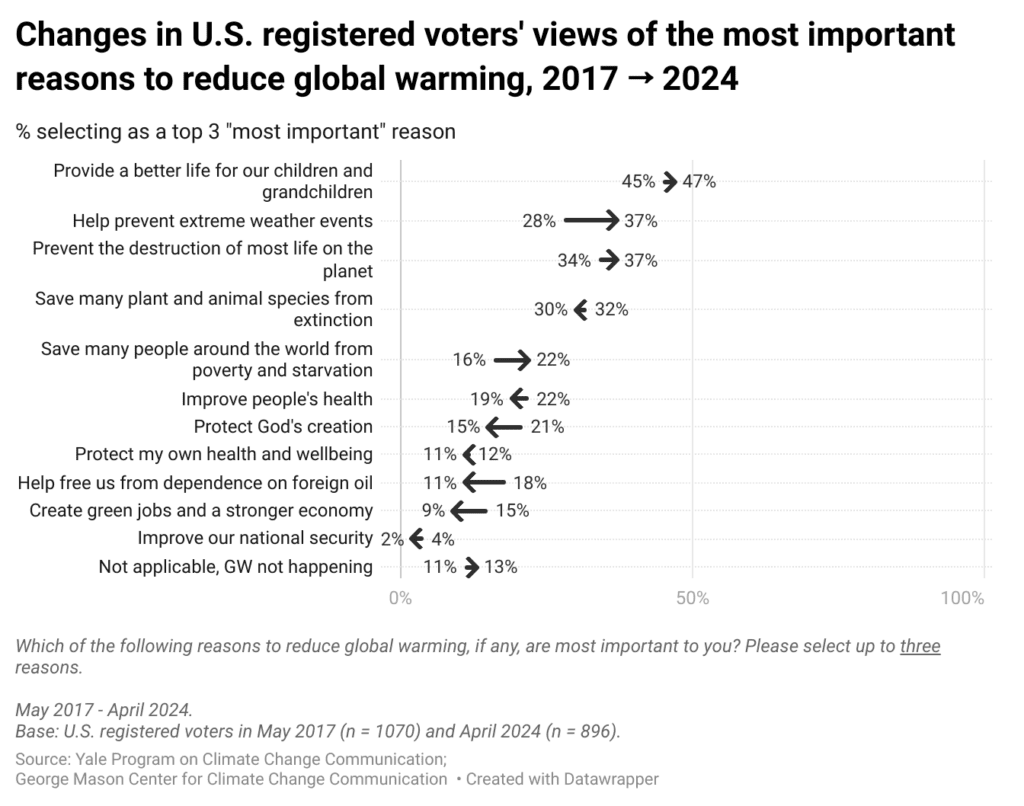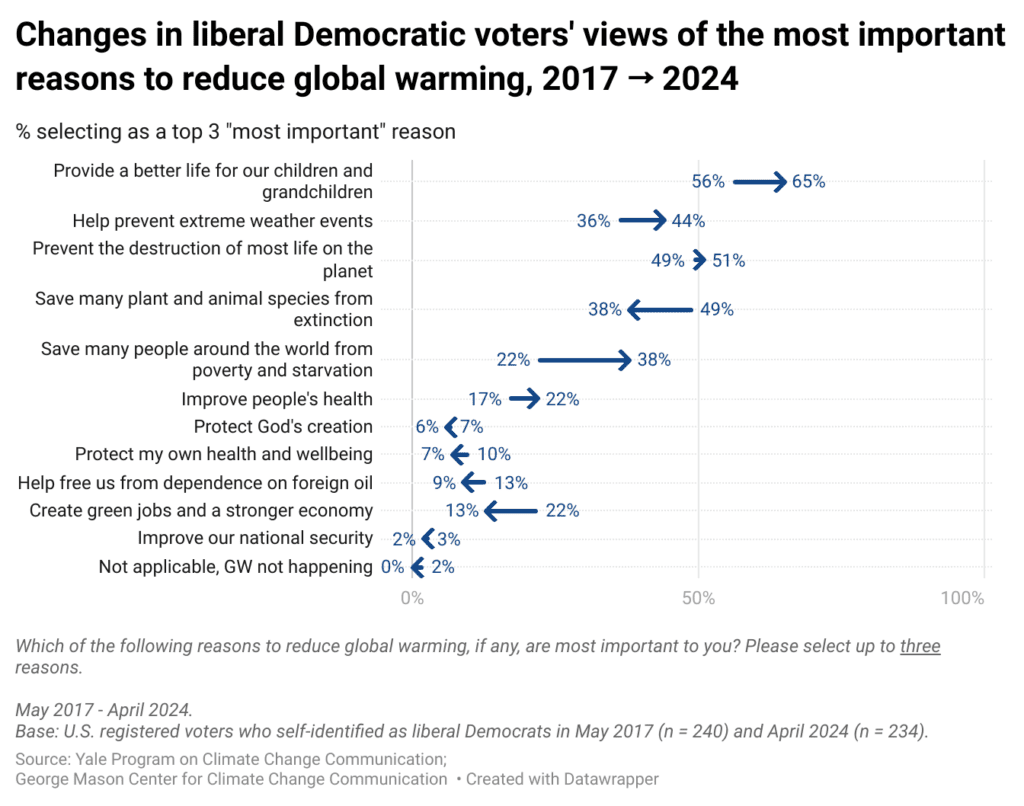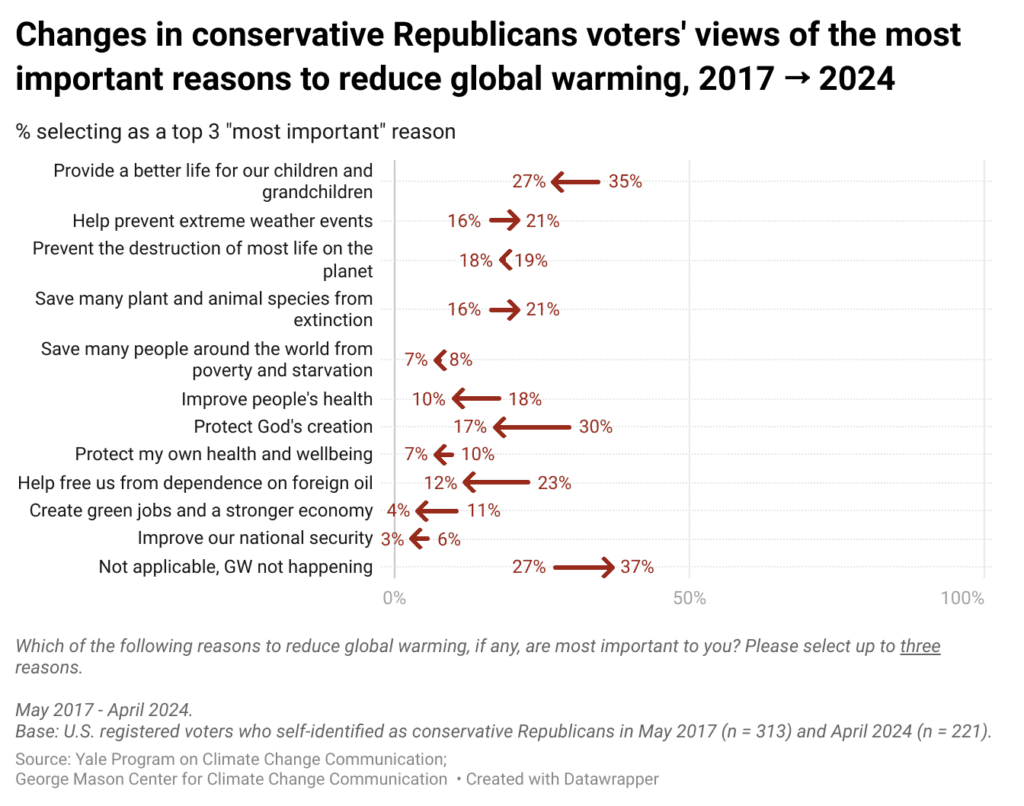Climate Note · Sep 12, 2024
Changes in U.S. voters’ top reasons to reduce global warming
By Jennifer Carman, Marija Verner, Seth Rosenthal, John Kotcher, Edward Maibach and Anthony Leiserowitz
Filed under: Policy & Politics

People get involved in climate action for different reasons. Some people want to benefit their community through development of renewable energy resources. Others want to protect their grandchildren from the long-term harms of climate change. Knowing why people feel it is important to reduce global warming is valuable because it can help climate communicators better understand their audiences, and thus develop better messages to reach them.
As part of the latest Climate Change in the American Mind survey (April 2024), we asked respondents to select up to three reasons to reduce global warming (from a list of 11) that are most important to them. We also asked the same question in May 2017. Here, we summarize results for U.S. registered voters overall and by political party/ideology and compare these results to those from May 2017.
Overall changes in voters’ reasons to reduce global warming
The three reasons to reduce global warming that voters selected most often were to provide a better life for our children and grandchildren (47%), to help prevent extreme weather events (37%), and to prevent the destruction of most life on the planet (37%).
There were significant increases since 2017 in the percentage of voters who selected “to help prevent extreme weather events” (+9 percentage points, 28% to 37%) and who selected “to save many people around the world from poverty and starvation” (+6 percentage points, 16% to 22%) as one of their top three reasons. By contrast, there were significant declines in the percentage who selected “to help free us from dependence on foreign oil” (-7 percentage points, 18% to 11%), “to protect God’s creation” (-6 percentage points, 21% to 15%), and “to create green jobs and a stronger economy” (-6 percentage points, 15% to 9%). The other reasons did not change significantly from 2017 to 2024.
Changes by party and ideology
Of the possible reasons to reduce global warming, the most common selections among liberal Democrats were “to provide a better life for our children and grandchildren” (65%), “to prevent the destruction of most life on the planet” (51%), and “to help prevent extreme weather events” (44%). These percentages did not change significantly between 2017 and 2024.
Additionally, among liberal Democrats, the percentage who selected “to save many people around the world from poverty and starvation” increased from 22% in 2017 to 38% in 2024 (+16 percentage points). By contrast, the percentage who selected “to save many plant and animal species from extinction” decreased (-11 percentage points, 49% to 38%), as did “to create green jobs and a stronger economy” (-9 percentage points, 22% to 13%).
The most frequent selections among moderate/conservative Democrats were “to provide a better life for our children and grandchildren” (52%), “to help prevent extreme weather events” (51%), and “to prevent the destruction of most life on the planet” (45%).
Among moderate/conservative Democrats, the percentage who selected “to help prevent extreme weather” increased from 31% in 2017 to 51% in 2024 (+20 percentage points). The percentage who selected “to save many people around the world from poverty and starvation” also increased (+9 percentage points, 17% to 26%). By contrast, fewer moderate/conservative Democrats selected “to protect God’s creation” (-9 percentage points, 25% to 16%) or “to help free us from dependence on foreign oil” (-8 percentage points, 14% to 6%).
The most frequent selections among liberal/moderate Republicans were “to provide a better life for our children and grandchildren” (43%), “to prevent the destruction of most life on the planet” (31%), “to save many plant and animal species from extinction” (30%), and to “help prevent extreme weather events” (29%). None of these percentages changed significantly from 2017 to 2024.
The percentage of liberal/moderate Republicans who selected “to help free us from dependence on foreign oil” significantly decreased from 25% in 2017 to 13% in 2024 (-12 percentage points). The percentage who selected “to improve people’s health” (-11 percentage points, 25% to 14%), and “to create green jobs and a stronger economy” (-10 percentage points, 18% to 8%) also decreased.
Of the possible reasons to reduce global warming, the most frequent selections among conservative Republicans were “to provide a better life for our children and grandchildren” (27%), “to help prevent extreme weather events” (21%), and “to save many plant and animal species from extinction” (21%). However, the largest percentage of conservative Republicans selected “Not applicable because global warming isn’t happening” for this question (37%).
Additionally, compared to 2017, the percentage of conservative Republicans who selected “to protect God’s creation” declined (-13 percentage points, 30% to 17%), along with “to help free us from dependence on foreign oil” (-11 percentage points; 23% to 12%), “to improve people’s health” (-8 percentage points, 18% to 10%) and “to create green jobs and a stronger economy” (-7 percentage points, 11% to 4%). Among conservative Republicans, the only selection that increased from 2017 to 2024 was “not applicable because global warming isn’t happening” (+10 percentage points, 27% to 37%).
Key Takeaways
Providing a better life for our children and grandchildren was the top reason to reduce global warming among all registered voters, and also among each party/ideology group. This finding remains consistent over time and aligns with research finding that urgent, generational messaging regarding climate change is effective across audiences and international contexts as a way to increase support for government action on climate change.
We find that some of the arguments for climate action that are framed to reflect conservative values may have lost support over time, especially among Republicans. For example, both liberal/moderate and conservative Republicans were less likely to say that they wanted action on global warming to protect God’s creation or to reduce dependence on foreign oil. In particular, conservative Republicans are now most likely to say that none of the options apply because global warming isn’t happening. (Note, however, that this was not the case among liberal/moderate Republicans.) The economic argument for climate action also declined in endorsement among most groups, with all groups other than moderate/conservative Democrats less likely to say that creating green jobs and a stronger economy is one of their top reasons to reduce global warming.
Nonetheless, several reasons, most notably protecting people from extreme weather, have increased significantly in endorsement since 2017. This suggests that while many voters think protecting future generations is an important reason to act, they might be increasingly motivated by present-day concerns as well. Compared to 2017, registered voters are more likely to say preventing extreme weather and harm to others (preventing destruction of life, saving plants and animals, saving people from poverty and starvation) are reasons to reduce global warming. Notably, the greatest increases in endorsement were to prevent extreme weather events (particularly among moderate/conservative Democrats) and to protect people around the world from poverty and starvation. The changes may reflect an increasing recognition that many climate change impacts are already here.
Methods
The results of this analysis are based on data from the April 2024 wave (n = 1,031, including 896 registered voters) and the May 2017 wave (n = 1,266, including 1,070 registered voters) of the twice-yearly Climate Change in the American Mind survey – a nationally representative survey of U.S. public opinion on climate change conducted by the Yale Program on Climate Change Communication and the George Mason University Center for Climate Change Communication. Data were collected from April 25 – May 4, 2024, and May 18 – June 6, 2017, using the Ipsos KnowledgePanel®, a representative online panel of U.S. adults ages 18 and older. Questionnaires were self-administered online in a web-based environment.
This analysis includes only registered voters. Data were weighted to align with demographic parameters in the United States. Among the subset of registered voters, references to Republicans and Democrats throughout include respondents who initially identify as either a Republican or Democrat, as well as those who do not initially identify as a Republican or Democrat but who say they “are closer to” one of those parties (i.e., “leaners”) in a follow-up question. The category “Independents” does not include any of these “leaners.” Independents and respondents who do not identify with a party or are not interested in politics are not included in this report due to small sample size.
Group differences were tested for statistical significance using the weighted proportions and unweighted sample sizes of each group. The average margin of error is +/- 3.3 percentage points at the 95% confidence interval for the subset of registered voters who participated in the survey in April 2024 (n = 896) and +/- 3.0 percentage points for the May 2017 survey (n = 1,070). Weighted sample proportions and average margins of error at the 95% confidence interval for the subgroups are:
- April 2024
- Liberal Democrat +/- 6.4 percentage points (n = 234; 26% of weighted sample)
- Moderate/conservative Democrat +/- 7.1 percentage points (n = 188; 20% of weighted sample)
- Liberal/moderate Republican +/- 9.4 percentage points (n = 109; 12% of weighted sample)
- Conservative Republican +/- 6.6 percentage points (n = 221; 24% of weighted sample)
- May 2017
- Liberal Democrat +/- 6.3 percentage points (n = 240; 23% of weighted sample)
- Moderate/conservative Democrat +/- 6.6 percentage points (n = 219; 21% of weighted sample)
- Liberal/moderate Republican +/- 8.7 percentage points (n = 127; 11% of weighted sample)
- Conservative Republican +/- 5.5 percentage points (n = 313; 27% of weighted sample)
View Data Tables for accessibility




